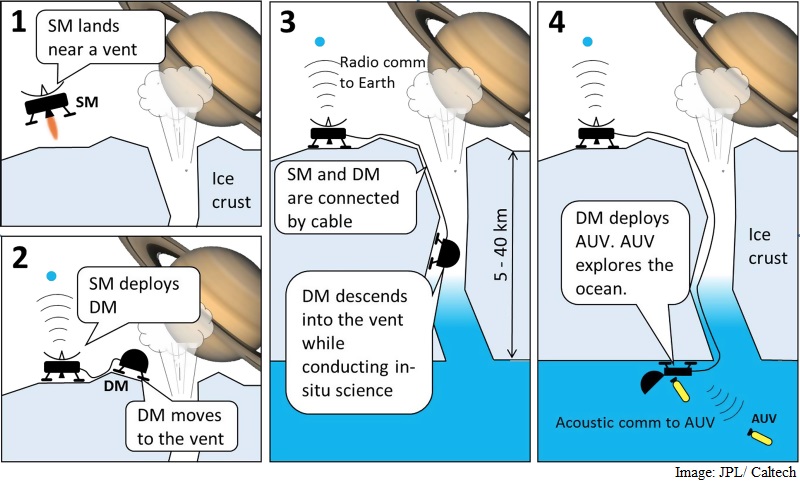- Home
- Science
- Science News
- JPL Proposes Sending Robots to Europa, Enceladus to Search for Life
JPL Proposes Sending Robots to Europa, Enceladus to Search for Life

The two possible candidates are: the icy moons of gas giants Jupiter and Saturn which harbour sub-surface oceans perfect for hosting life.
According to a recent study, Jupiter's moon Europa is creating a strong gravitational pull which is creating more heat on the moon's ice-sheet that is enough to support a sub-surface ocean.
But it is Saturn's icy moon Enceladus 500 km in diameter and 1.272 billion km away from the Earth - that serves as a leading candidate for extra-terrestrial life.
This year, one of most promising proposals that Nasa Innovative Advanced Concepts Programme (NIAC) has received is from the researchers at the Jet Propulsion Laboratory (JPL) at Pasadena, California - proposing robots to explore the icy moons.
The Icy-Moon Cryovolcano Explorer (ICE) project aims to land on these moons and send a robotic explorer down the ice volcano to deploy a submersible to explore the ocean.
With a thick icy crust, Europa may be tough for a drilling robot to reach the subsurface ocean so the researchers have now turned their eyes on Enceladus.
The data from Nasa's Cassini probe has strongly indicated that the cryovolcanic plumes of Enceladus probably originate in a biomolecule-friendly oceanic environment.
Enceladus, which probably has an ocean underlying its icy surface, has somehow managed to sprout multiple fissures along its south pole.
A surface-to-subsurface robotic system, the ICE will land on the surface of an icy moon, traverse to a cryovolcano, descend into its opening, perform in-situ science in the vent or crevasse and ultimately deploy underwater vehicles to explore a subsurface ocean.
ICE involves three modules: Descent Module (DM), Surface Module (SM) and autonomous underwater vehicles (AUVs_.
DM will carry AUVs and descend into a vent by using a combination of roving, climbing and hopping, like an experienced human alpinist.
SM will stay on the surface, generating power and communicating with the Earth.
DM will rely on the power and communication link provided by SM through a cable to minimise the size and weight.
Once DM reach the subsurface ocean, it will launch the AUVs to explore the exotic environment that potentially harbours life.
ICE brings three unique benefits. First, it enables in-situ science in a cryovolcano vent.
Although orbiters can perform in-situ science of plumes, relatively large dust grains are hard to reach orbital altitude. Yet it is those mineral grains that carry rich information about the habitability of the subsurface ocean.
Second, ICE enables the exploration of subsurface oceans by providing an access to it.
Third, it enables the operation of AUVs in subsurface ocean by providing three essential services: communication, localisation and power.
"A successful completion of the project will mature this exciting concept into a credible element of the growing outer planets and icy moons exploration portfolio," the US space agency said in a statement.
Catch the latest from the Consumer Electronics Show on Gadgets 360, at our CES 2026 hub.
Related Stories
- Samsung Galaxy Unpacked 2025
- ChatGPT
- Redmi Note 14 Pro+
- iPhone 16
- Apple Vision Pro
- Oneplus 12
- OnePlus Nord CE 3 Lite 5G
- iPhone 13
- Xiaomi 14 Pro
- Oppo Find N3
- Tecno Spark Go (2023)
- Realme V30
- Best Phones Under 25000
- Samsung Galaxy S24 Series
- Cryptocurrency
- iQoo 12
- Samsung Galaxy S24 Ultra
- Giottus
- Samsung Galaxy Z Flip 5
- Apple 'Scary Fast'
- Housefull 5
- GoPro Hero 12 Black Review
- Invincible Season 2
- JioGlass
- HD Ready TV
- Laptop Under 50000
- Smartwatch Under 10000
- Latest Mobile Phones
- Compare Phones
- Honor Magic 8 RSR Porsche Design
- Honor Magic 8 Pro Air
- Infinix Note Edge
- Lava Blaze Duo 3
- Tecno Spark Go 3
- iQOO Z11 Turbo
- OPPO A6c
- Samsung Galaxy A07 5G
- Lenovo Yoga Slim 7x (2025)
- Lenovo Yoga Slim 7a
- Lenovo Idea Tab Plus
- Realme Pad 3
- Moto Watch
- Garmin Quatix 8 Pro
- Haier H5E Series
- Acerpure Nitro Z Series 100-inch QLED TV
- Asus ROG Ally
- Nintendo Switch Lite
- Haier 1.6 Ton 5 Star Inverter Split AC (HSU19G-MZAID5BN-INV)
- Haier 1.6 Ton 5 Star Inverter Split AC (HSU19G-MZAIM5BN-INV)







![[Sponsored] Haier C90 OLED TV | Dolby Vision IQ, 144Hz OLED and Google TV in Action](https://www.gadgets360.com/static/mobile/images/spacer.png)









